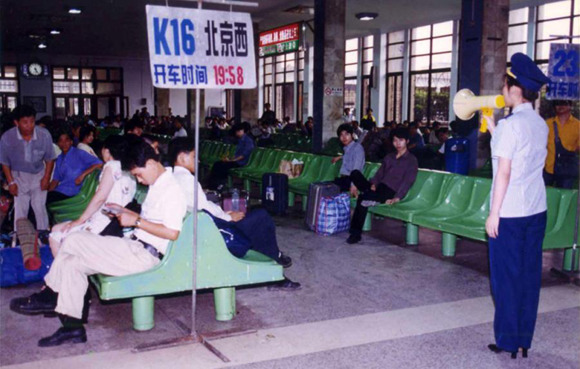
A staff member prompts passengers to get on the train in the waiting room of Guangzhou Railway Station in the early 1990s. (Photo/Courtesy of Guangzhou Railway Station)
Guangzhou Railway Station, in the southern province of Guangdong, is one of the busiest in China. Each year around the Lunar New year, countless passengers who have moved to the Pearl River Delta for work head home via the station.
Spring Festival, or Chinese Lunar New Year, falls on Feb. 16 this year. Hundreds of millions of Chinese will return to their hometowns for family gatherings or travel around the country, putting huge pressure on the transportation system.
About 2.98 billion trips are expected to be made during the 2018 Spring Festival travel rush between Feb. 1 and March 12, approximately the same figure as last year, according to China's top economic planner.
As the annual travel rush, known as "Chunyun," began, Xinhua reporters visited the station to record the changes that have taken place in recent decades.
TV SETS, URINE TOWELS AND CATTLE CARS
The station was built in 1974.
"In the 1970s, the station could accommodate about 25,000 people, and there were not many passengers at that time," said Zhu Haibin, head of the station's security department. "But the station began to become crowded after the opening-up and reform policy in 1978."
The policy's economic reforms introduced market principles, such as opening to foreign investment, allowing entrepreneurs to start businesses, and privatization of state-owned industries.
Since then, the Pearl River Delta Economic Zone -- whose nine cities include Guangzhou, Dongguan, and Shenzhen -- started to take off under preferential policies, thanks in part to its proximity to Hong Kong and Macao, which were more developed than the Chinese mainland.
The boom of labor-intensive industries in the delta attracted a great number of migrant workers, or "Gold Diggers," making Guangzhou Railway Station one of the busiest in the region.
"Before 1978, passengers at the station numbered fewer than 10,000, but now it handles an average of 300,000 passengers per day," said Zhu. "This is especially obvious during Chunyun, when a lot of people need to go home via the station."
In order to reunite with family for the year's most important festival, passengers would wait in lines almost five kilometers long just to get a ticket. Some even waited overnight through the cold wind and long queues only to find tickets to their hometown were sold out, Zhu said.
"I saw passengers with lots of items on their carrying poles," Zhu recalled. "There were TV sets, pots, bowls and basins in colorful, bulging plastic bags."
Guangzhou registered fewer than 20,000 migrant workers in 1976, but the number surged to 450,000 in 1987, according to the Guangdong-based Yangcheng Evening News.
One in every seven people living in Guangzhou in 1987 was a migrant worker, according to the newspaper.
"To send more people home during Chunyun, even cattle cars were used," Zhu said.
The windowless stock cars were crammed with more than 5,000 people during the hectic Chunyun period in the 1990s, according to Zhu.
"There were layers of hay and some chairs on the car, but most people just stood," Zhu said. "It was so crowded that we had to 'push' people in."
Those pushed onto the cars would even thank Zhu for doing so, because it meant they were finally on board and heading home.
Some passengers brought towels to urinate on during their trips, as the livestock cars were too crowded and had no restrooms, he said.
Despite the terrible conditions, the cars were as popular as they were cheap.
"A ticket from Guangzhou to Hunan's Hengyang, 500 km away, cost only 16 yuan (2.5 U.S. dollars), about half the price of a normal train ticket," Zhu said.
During summer holidays, the grandparents would take the left-behind children to Guangzhou to visit their migrant worker parents.
"Migrant workers from one village usually all work in the same factory, so their children typically come together," Zhu said. "In the station, we could see two senior citizens taking a bunch of kids, bound together by a leash to prevent them from running away."


















































